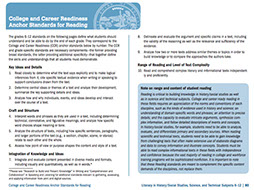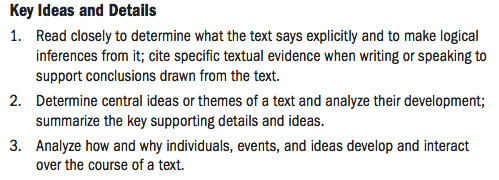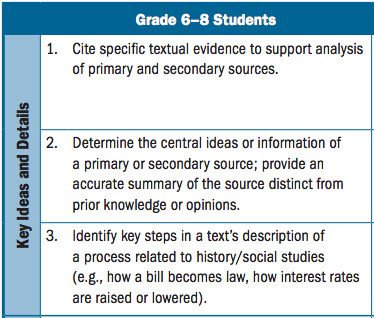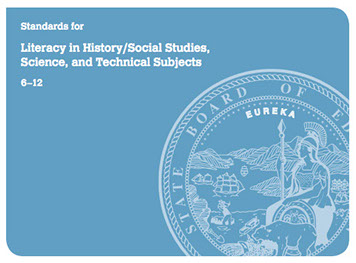Teaching Secondary Reading
A Resource for Improving Academic Literacy with Adolescents ©2015
Common Core
California has long required all teachers, no matter the subject they taught, to be trained in teaching reading. But in 2010, the state of California adopted the Common Core Standards for Literacy in History/Social Studies, Science, and Technical Subjects, for the first time holding content area teachers accountable to a specific performance.
That specific performance is a challenge for teachers to meet. This section introduces the Common Core Literacy Standards that provide the blueprint for that challenge.
The Common Core Literacy Standards were adopted along with standards for English Language Arts and Mathematics. They were collaboratively written by leaders in many states to provide consistent, clear, strong benchmarks of student performance. This video explains the intent of the Common Core Standards. While some controversy has accompanied their adoption, the Common Core is currently the guiding document for California instruction in language, literacy and math.
Implementing the Common Core in literacy involves three important shifts in how we approach instruction:
1. Regular practice with complex text and its academic language
2. Reading, writing, and speaking are grounded in evidence from text, both literary and informational
3. Building knowledge through content-rich nonfiction
How is the Common Core Organized?
The Common Core Standards for Literacy in History/Social Science, Science, and Technical Subjects are included as part of the Common Core Standards in English/Language Arts. For grades K-5, the literacy standards are included in English/Language Arts. For grades 6-12, the literacy standards make up a separate section. In the actual document, the Literacy Standards for middle and high school teachers can be found on pages 79-89.
 Page 80 shows the College and Career (CCR) Anchor Standards in Reading, and page 85 shows the College and Career Anchor Standards in Writing. These CCR Standards are actually the same for all public school students. These are the same broad goals of the Common Core. As they are revisited each year in the more detailed grade level standards, they are deepened and made more complex.
Page 80 shows the College and Career (CCR) Anchor Standards in Reading, and page 85 shows the College and Career Anchor Standards in Writing. These CCR Standards are actually the same for all public school students. These are the same broad goals of the Common Core. As they are revisited each year in the more detailed grade level standards, they are deepened and made more complex.
Note that each anchor standard, like the common core standards, is also part of a group. the titles of these groups also articulate the larger focus of the CCR and Common Core standards. Standards 1-3 are a group called "Key Ideas and Details." "Craft and Structure" includes standards 4-6, "Integration of Knowledge and Ideas" standards 7-9, and standard 10 is labeled "Range of Reading and Level of Text Complexity."
The grade level Reading Standards for History and Social Studies (RH) are located on pages 81-82, and the Reading Standards for Science and Technical Subjects (RST) are on pages 83-84. The Writing Standards for History/Social Studies, Science and Technical Subjects (WHST) are on pages 86-89. Teachers are accountable to the standards for their content and grade level in both reading and writing.
On each page, the standards for grades 6-8 are on the left, for grades 9-10 are in the middle, and the standards for grades 11-12 are on the right. Read across left to right to track the articulation of standards across grade levels.
Below, first compare the CCR Standards 1-3, left, with the RH Standards 1-3 for grades 6-8, right:


Next, compare how RH Standards 1-3 compare across the grade levels. Notice how the expectations for student knowledge and skills spiral up with each grade level.

You will find a similar pattern across all ten reading standards and all ten writing standards. Take the time to examine the standards for your content area and grade level, as well as how they are related to the standards for the other content areas and grade levels.
Activity. This activity, Analysis of Content Standards, asks you to take a stab at creating a content literacy activity with a partner. You will need your grade level content standards as well as the Common Core Literacy Standards at your grade level.
How does the Common Core guide instruction?
The Common Core Literacy Standards for grades 6-12 are aimed at content area teachers, that is, science, history, social studies, arts, etc. The Standards describe the literacy knowledge and skills that students at each grade level should have attained by the end of the school year.
In backwards planning, the first step is to designing a lesson is to identify the desired results of instruction. While science teachers may be accustomed to building their lesson plans on the science standards, and history teachers build their lessons upon the history standards, now they expected to integrate high-quality literacy instruction, appropriate to their content, in their science and history lessons. The Common Core provides the blueprint for planning literacy instruction in the content area.
Use the Common Core Literacy Standards to create literacy objectives, just as you might use the science standards to create lesson objectives in your science class. Effective instruction begins with strong objectives in both academic literacy and the content area.
An important resource included with the Common Core Standards is Appendix B: Text Exemplars and Sample Performance Tasks. Beginning on page 130, you will find complex text excerpts from informational texts in history/social studies and science, mathematics, and technical subjects, along with examples of appropriate assessments.
Tools for Planning
Achieve the Core provides an excellent, comprehensive online Lesson Planning Tool. You will also find at that site sample lessons and resources to identify and develop Complex Texts, Text-Dependent Questions, Academic Vocabulary, and Writing Assignments.
The Common Core Literacy Standards challenge content area teachers to lead their students to high level literacy.
The Common Core is based on the College and Career Readiness Anchor Standards (pages 80 and 85).
The views and opinions expressed on unofficial pages of California State University, Dominguez Hills faculty, staff or students are strictly those of the page authors.
The content of these pages has not been reviewed or approved by California State University, Dominguez Hills.
